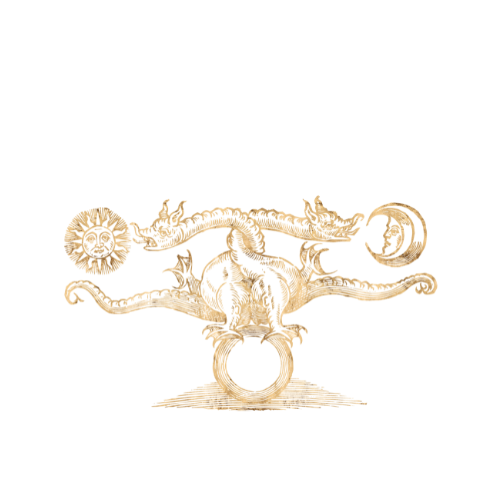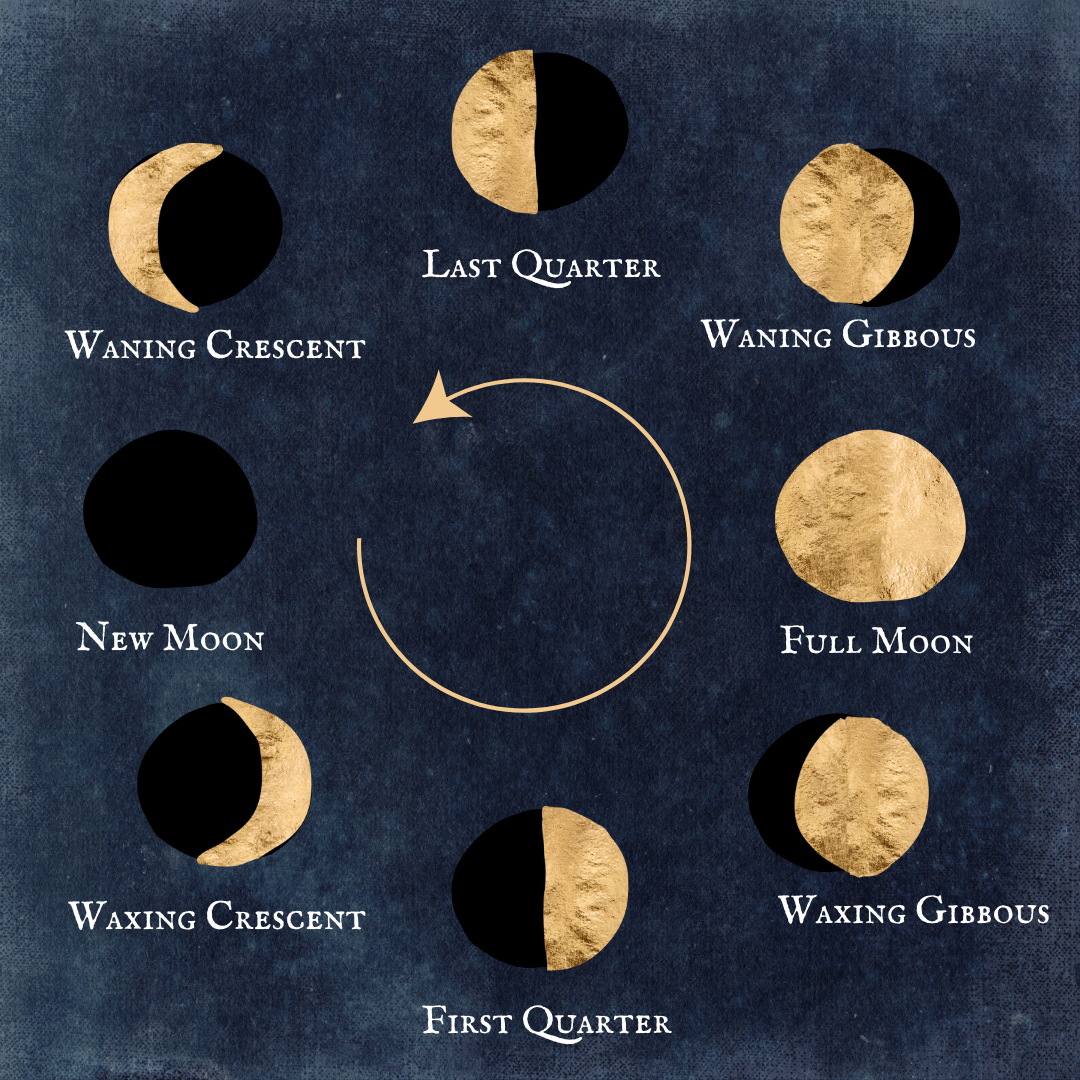How To Build a Moon Ritual
Hello and welcome to the first article in a series I’ll be creating on the topic of astrological rituals! There are so many different applications of ritual, and so many ways to link astrology with ritual acts. This practice offers us all the opportunity to take astrology “off the screen,” and give it earthly form. I’m delighted to open a window into this world for you, and hope that this is a helpful and inspiring guide!
Our first exploration will be focused on creating astrologically attuned rituals based, on the Full or New Moon.
Why Work with the Full Moon or New Moon?
A lunar cycle is about 28.5 days long, and in that span of time, the Moon waxes and wanes, growing and shrinking in the sky, relative to her geometrical position to the Sun.
The Moon is the closest celestial body to Earth, and as a result of that, she has a considerable energetic impact on life on this planet. The ancients saw the Moon as the final realm, or sphere, through which all other cosmic energies passed, thus the Moon is an important intermediary between mundane life and heavenly influences. She controls the tides, impacts the way we plant and harvest crops, and is linked to the rhythm of the menstrual cycle and the womb. We love Luna and all she has to offer us.
Each month, the Sun and Moon have two critical meetings, the New Moon and the Full Moon. The New Moon is observed each month when the Sun and Moon connect in the same degree of the zodiac. For example, February 2023’s New Moon will happen at 1° Pisces, when the Sun and Moon meet there simultaneously. The New Moon is understood as a moment of pause, of reflection, and of turning inward. As there is no lunar light for us to see, our emotions and intuition tend to feel like they’re harder to access, or more obscure. At the New Moon, we rest, reflect, and get ready to set fresh intentions, as the Moon begins to grow in light a few days after her “new” moment.
The Full Moon is observed when the Sun and Moon sit at opposite points of the zodiac, 180° away from one another. This is when the Moon receives peak light from the Sun, and appears at her largest, most brilliant luminosity. Full Moons symbolize a moment of manifestation. As the Sun and Moon reach their peak distance from one another, there is a sense of something being completed, or released, on the psycho-spiritual and material planes. Emotions are also peaking at this time, and the Full Moon is traditionally considered a time of mischief and nighttime eccentricity.
When we work with the Moon, we can realize that not everything needs to be a rush and a push. We do not need to constantly be striving for growth all the time. In fact, our closest celestial ally, the Moon, has discrete periods of wax and wane, growth and pruning, and we too should move with this rhythm in mind. It’s a lovely, simple, anti-capitalist gesture. The Moon is not always “doing,” and you don’t have to be, either.
The Components of Lunar Ritual
To get us started, a lunar ritual can be defined as a way of honoring the Moon and her cycle. When we create a lunar ritual, we look to:
1) The chart of the moment - what phase is the Moon in, and what sign?
2) What degree does she occupy? This alerts us to the decan the Moon is activating at this time, which in turn gives us more info into how that energy is expressed, as well as what tarot card corresponds to the lunar moment.
Your ritual can be comprised of an altar and a series of offerings, or simply lighting a candle with intention and going about your day, or offerings left out with a prayer for Luna, or using the time you place your offerings on the altar as a time to meditate, make art, journal etc.
The following sections will guide you towards learning how to find all the details you need to build an astrologically attuned lunar ritual. Please note that I am not saying this is the only way to connect with the Moon, but rather is a reflection of my own practice, which I am happy to share with you :)
Identifying Important Lunar Details
When a Full/New Moon (hereafter referred to as a lunation) arrives, we look at a few different details to get a sense of what this lunation entails, how to read it, what to expect from it, and of course, how to connect with it. Here’s where to start:
Step 1: Identifying the Moon’s Sign
First, we look to the sign of the zodiac that the lunation occurs in, and reflect on the qualities of that sign. What stories do you know about that sign? What is its element (air, fire, earth, water)? What modality does it have (cardinal, fixed, mutable)? Does the Moon like to be in this sign (Cancer/Taurus), or does she perhaps feel less resourced here (Capricorn/Scorpio)? All of these detail can help us understand right away what the interpretation of the lunation may be.
Step 2: Finding the Relevant Decan
Decans are a way of subdividing the zodiac’s twelve signs into thirty six discrete pieces, something that ancient astrologers created to bring more nuance to the signs.
Each sign of the zodiac is divided into three decans, each of them ten degrees of zodiacal space, and each of them ruled by a particular planet.
These divisions follow something called the Chaldean order, which is the perceived ordering of the planets, according to ancient astrologers. The planets are arranged in order of speed and distance from earth, with the Moon being the closest, fastest luminary, and Saturn being the farthest, slowest visible planet.
The decans begin at 0° Aries, and since Mars is the planet that rules Aries, the first decan is ruled by Mars. Following the Chaldean order, the second decan of Aries is ruled by the Sun, and the third by Venus. From here, the ordering flows cyclically, through the thirty-six decans.
When we know what decan is activated by the lunation in question, we get more information to work with, for ritual purposes. For example, on February 19th’s New Moon in Pisces, our 1° Pisces New Moon will be in the first decan of Pisces, which according to the table below, is ruled by Saturn. This means that Saturn has a certain energetic influence in the New Moon, and might show up in our experiences with that lunation. We could also look to Saturn in the chart of the lunation to see what other insights may come through. His sign and aspects made to/from him will be helpful for us here. Here are the decans according to Alexandrian Egyptian astrologer, Claudius Ptolemy:
Table via Wikipedia
Step 3: Connecting the Activated Decan with a Tarot Card
There are myriad ways in which the tarot and astrology overlap! For example, the cards in the major arcana are often correlated to the signs and planets, or there may be astrological symbolism drawn onto the cards themselves (I’m thinking of the Chariot card, in the Rider Waite deck, which shows a figure wearing a diadem with all twelve zodiac signs emblazoned on it). If you’d like to learn more about tarot and astrology’s connections, you can listen to this episode of my podcast, Soror Mystica, which explores this topic.
One of the most useful ways we can connect the tarot to astrology is by looking to a system of linking the minor arcana and the thirty six decans of the zodiac, first established by the Golden Dawn, a magical order established in Great Britain in the late 19th century.
Diagram via Astrology and Tarot
Looking to the degree of the lunation shows us the decan that is activated by that lunation. Looking then to the tarot card that is associated with the decan can give us extra language, another “story” or psychological approach to understanding the Full/New Moon, and show us important ways to access and work with the lunation itself.
To keep with our example of the New Moon in Pisces at 1°, we know that, according to the chart above, decan one of Pisces is governed by Saturn. The tarot correspondence would be the 8 of Cups, a card of turning away from the superficial crowds, and going off to explore shadow realms on the periphery of psyche.
Building Your Ritual
Image: Remedios Varo, To Be Reborn
We’ve gathered bundle of details here, haven’t we?! While this all may seem like a lot, let’s boil it down to a flow:
Phase 1: Identify the sign a lunation occurs in, and contemplate the energy and stories of this sign.
Phase 2: Notice where it sits in your natal chart, as the house will give you deeper insight into how the lunation impacts you directly.
Phase 3: Notice the degree of the lunation. This points you to the particular decan that is activated. Take note of the planet that rules that decan for more insight into the energy of the lunation.
Phase 4: Look for the tarot correspondence for that particular decan for deeper understanding of stories, experiences, symbols, and ways to work with the energy of the Full/New Moon.
These four components will get you quite far in terms of building your own ritual practice around the Moon. If you’d like some altar suggestions for each of the seven traditional planets, as well as the Orphic Hymns for each planet, check out my Reference Guide to the Planets.
∞
Your ritual work is going to be totally unique, and when you are building a personal relationship with the Moon and her cycle, there are no right or wrong answers. The Moon asks us to tune in with our emotional core, our psychic states, our intuitive desires, our ancestral stories. She is highly personal, and deeply compassionate. After you take note of all the cerebral details I’ve listed above, I encourage you to feel your way into ritual. Bring them together as you see best fit.
You might simply light a candle, pull that tarot card and place it on the altar, and say a prayer or meditate for a few moments. You might be more elaborate, setting out a tableful of offerings, reading the Orphic hymn to the Moon, and use the time for automatic writing, creating some art, or practicing breath work. It’s up to you. Ritual work is an art form, and there is really nothing more important for us as people living in a very disenfranchised world, to have as many artistic practices as possible, as well as as many ways to connect with the earth, the cosmos, and its cycles, as we can.
Happy ritual-ing!
Resources for Further Exploration:
T. Susan Chang’s blogs on the various decans are absolute treasures. Check them out here.
Austin Coppock’s column on the decans is no longer updated, but is still full of great insight, here.
Demetra George on the lunar cycle is a great resource, here!










